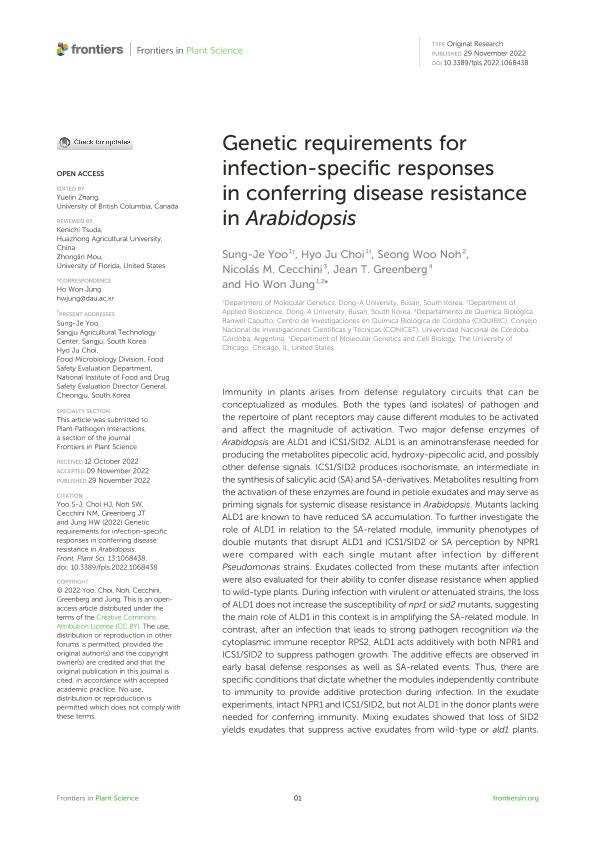Mostrar el registro sencillo del ítem
dc.contributor.author
Yoo, Sung-Je
dc.contributor.author
Choi, Hyo Ju
dc.contributor.author
Noh, Seong Woo
dc.contributor.author
Cecchini, Nicolas Miguel

dc.contributor.author
Greenberg, Jean T.

dc.contributor.author
Jung, Ho Won
dc.date.available
2023-08-24T12:51:20Z
dc.date.issued
2022-11
dc.identifier.citation
Yoo, Sung-Je; Choi, Hyo Ju; Noh, Seong Woo; Cecchini, Nicolas Miguel; Greenberg, Jean T.; et al.; Genetic requirements for infection-specific responses in conferring disease resistance in Arabidopsis; Frontiers Media; Frontiers in Plant Science; 13; 11-2022; 1-16
dc.identifier.uri
http://hdl.handle.net/11336/209200
dc.description.abstract
Immunity in plants arises from defense regulatory circuits that can be conceptualized as modules. Both the types (and isolates) of pathogen and the repertoire of plant receptors may cause different modules to be activated and affect the magnitude of activation. Two major defense enzymes of Arabidopsis are ALD1 and ICS1/SID2. ALD1 is an aminotransferase needed for producing the metabolites pipecolic acid, hydroxy-pipecolic acid, and possibly other defense signals. ICS1/SID2 produces isochorismate, an intermediate in the synthesis of salicylic acid (SA) and SA-derivatives. Metabolites resulting from the activation of these enzymes are found in petiole exudates and may serve as priming signals for systemic disease resistance in Arabidopsis. Mutants lacking ALD1 are known to have reduced SA accumulation. To further investigate the role of ALD1 in relation to the SA-related module, immunity phenotypes of double mutants that disrupt ALD1 and ICS1/SID2 or SA perception by NPR1 were compared with each single mutant after infection by different Pseudomonas strains. Exudates collected from these mutants after infection were also evaluated for their ability to confer disease resistance when applied to wild-type plants. During infection with virulent or attenuated strains, the loss of ALD1 does not increase the susceptibility of npr1 or sid2 mutants, suggesting the main role of ALD1 in this context is in amplifying the SA-related module. In contrast, after an infection that leads to strong pathogen recognition via the cytoplasmic immune receptor RPS2, ALD1 acts additively with both NPR1 and ICS1/SID2 to suppress pathogen growth. The additive effects are observed in early basal defense responses as well as SA-related events. Thus, there are specific conditions that dictate whether the modules independently contribute to immunity to provide additive protection during infection. In the exudate experiments, intact NPR1 and ICS1/SID2, but not ALD1 in the donor plants were needed for conferring immunity. Mixing exudates showed that loss of SID2 yields exudates that suppress active exudates from wild-type or ald1 plants. This indicates that ICS1/SID2 may not only lead to positive defense signals, but also prevent a suppressive signal(s).
dc.format
application/pdf
dc.language.iso
eng
dc.publisher
Frontiers Media

dc.rights
info:eu-repo/semantics/openAccess
dc.rights.uri
https://creativecommons.org/licenses/by/2.5/ar/
dc.subject
ARABIDOPSIS ALD1
dc.subject
AVIRULENT PSEUDOMONAS
dc.subject
PETIOLE EXUDATES
dc.subject
PLANT IMMUNE RESPONSE
dc.subject
SALICYLIC ACID
dc.subject.classification
Bioquímica y Biología Molecular

dc.subject.classification
Ciencias Biológicas

dc.subject.classification
CIENCIAS NATURALES Y EXACTAS

dc.title
Genetic requirements for infection-specific responses in conferring disease resistance in Arabidopsis
dc.type
info:eu-repo/semantics/article
dc.type
info:ar-repo/semantics/artículo
dc.type
info:eu-repo/semantics/publishedVersion
dc.date.updated
2023-07-07T21:36:07Z
dc.identifier.eissn
1664-462X
dc.journal.volume
13
dc.journal.pagination
1-16
dc.journal.pais
Suiza

dc.description.fil
Fil: Yoo, Sung-Je. Dong-a University; Corea del Sur
dc.description.fil
Fil: Choi, Hyo Ju. Dong-a University; Corea del Sur
dc.description.fil
Fil: Noh, Seong Woo. Dong-a University; Corea del Sur
dc.description.fil
Fil: Cecchini, Nicolas Miguel. Consejo Nacional de Investigaciones Científicas y Técnicas. Centro Científico Tecnológico Conicet - Córdoba. Centro de Investigaciones en Química Biológica de Córdoba. Universidad Nacional de Córdoba. Facultad de Ciencias Químicas. Centro de Investigaciones en Química Biológica de Córdoba; Argentina
dc.description.fil
Fil: Greenberg, Jean T.. University of Chicago. Department of Molecular Genetics and Cell Biology; Estados Unidos
dc.description.fil
Fil: Jung, Ho Won. Dong-a University; Corea del Sur
dc.journal.title
Frontiers in Plant Science
dc.relation.alternativeid
info:eu-repo/semantics/altIdentifier/url/https://www.frontiersin.org/articles/10.3389/fpls.2022.1068438/full
dc.relation.alternativeid
info:eu-repo/semantics/altIdentifier/doi/http://dx.doi.org/10.3389/fpls.2022.1068438
Archivos asociados
